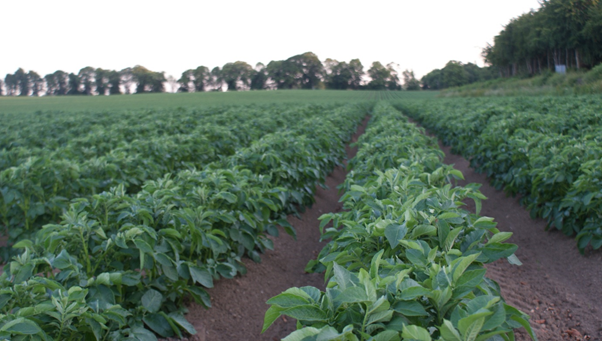Potato blight – Early June 2020
7 June 2020There have been no confirmed outbreaks of blight in Scotland so far this season. The shift to the wetter weather may well increase the risk.
Check with AHDB Potatoes Fight against Blight regularly for the most up to date information on outbreaks. Also, check BlightWatch or BlightCast for the general blight risk where your crops are located.
Preventing blight spreading from outgrade piles (dumps)
As is the case every year, it’s important to deal with any potential sources of primary inoculum. Doing this effectively will reduce the risk of crop infection and allow each fungicide application to have greater efficacy. Control with fungicides is more effective, and could be less expensive, if the amount of inoculum challenging the crop is reduced.
The best practice with outgrade piles is to prevent any haulm growth, i.e. there should be zero tolerance of green haulm. This is best achieved by covering and enclosing the pile under black polythene before any tubers have sprouted. The polythene should be examined regularly to ensure that it remains in place and intact.
Spray application of the only herbicide option now available to treat dumps, glyphosate, unfortunately needs to be delayed until after there is enough haulm growth on the dump to intercept the spray. Clearly, in this situation there is a high risk of blight spreading from the pile prior to glyphosate treatment. Two additional negative aspects of this approach are:
- The rate of haulm killing by glyphosate is likely to be too slow to prevent the spread of blight from the outgrade pile (this was clearly demonstrated by SRUC, with AHDB funding, in trials)
- It’s very likely that many repeat applications will be required to deal with successive emergence of plants from tubers at different depths in the pile.
See our Potato Blight Update and Virus management in seed potatoes for a comprehensive guide to the management of blight. The key advice is summarised below.
Blight control early in the growing season
Bear in mind that plant resistance is lowest when the plants are small (low, single-digit, number of leaves per stem). Resistance increases with growth stage because upper leaves are more resistant. Match the efficacy of sprays prior to rapid canopy development to the magnitude of the inoculum threat.
Blight control during rapid canopy
Protecting crops against blight during rapid canopy development is more difficult if
1) crops are planted late (not an issue in 2020) and
2) temperatures are high during this phase of growth because the very rapid growth of the haulm stretches fungicide protection.
Fungicide timing and curative activity
For the fungicidal control of blight, the timing of application in relation to high-risk weather influences efficacy. Protectant fungicides give better protection if they are applied a day or two before a high-risk period. Curative fungicides prevent more early infections from developing into lesions if applied shortly after a high–risk period. If the target spray day is on the first or second day of a high-risk weather period, then it’s essential to use a fungicide with curative activity. Within this timescale, the greater the delay between the high-risk period and curative application, the greater curative efficacy required from the fungicide.
Curative active ingredients boost coverage because they are either translaminar or systemic and therefore are redistributed in the plant.
For Seed Potatoes:
The recent warm sunny weather has led to a significant increase in aphid flights, with key virus vector aphids such as the peach-potato aphid and willow-carrot aphid being seen in yellow water traps or aphid suction traps. Consequently, seed growers should consider beginning their aphicide programme sooner rather than later.
- Identify and act against potential sources of virus such as groundkeepers in adjacent crops and potato dumps. Early roguing of potato plants exhibiting virus symptoms from ware and seed crops, and but groundkeepers from non-potato crops is an essential component of virus management in seed potatoes
- Assess propensity of variety to PLRV or to PVY using the SASA website
- The cumulative appearance of aphids throughout the season can be monitored from the AHDB network of aphid water traps and the UK network of aphid suction traps:
- This information can be used as an early warning system for local areas, and growers are encouraged to use data from both the water traps and the suction traps to gauge the threat from aphids and virus in their area
- Mineral oil adjuvants with a PPP can be applied weekly from early emergence until tuber initiation.
- Aphicide treatments should begin when key aphids are found in traps and continue every 7 days until burning down of the crop.
- When peach-potato aphids appear in traps or crops, include acetamiprid, thiacloprid, flonicamid or spirotetramat in your programme every 14 days
- Monitor regrowth after burning down and consider an aphicide to prevent virus transmission
Guidelines issued by the Scottish Aphid-Borne Virus Working Group, April 2020
Sign up to the FAS newsletter
Receive updates on news, events and publications from Scotland’s Farm Advisory Service


